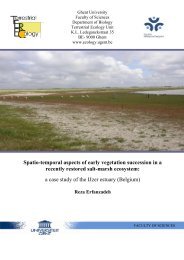PhD Arthur Decae 2010 - Ghent Ecology - Universiteit Gent
PhD Arthur Decae 2010 - Ghent Ecology - Universiteit Gent
PhD Arthur Decae 2010 - Ghent Ecology - Universiteit Gent
You also want an ePaper? Increase the reach of your titles
YUMPU automatically turns print PDFs into web optimized ePapers that Google loves.
forward with great force, and a facility for stabilizing the tunnel walls at its rear end (if it is<br />
tunneling in soft rocks). Now if we look at a mygalomorph spider through the eyes of a civil<br />
engineer we would recognize the perfect TBM (Fig. 2). The only difference between a<br />
mechanical TBM and an orthognate spider is the absence of a conveyor belt to remove the<br />
dug-out material. The problem of soil removal from the tunnel under construction is solved<br />
differently in spiders. The key solution to this problem is that spiders have a particularly<br />
narrow and extremely flexible waist, the pedicel that allows it to pivot in the narrow shaft of<br />
its tunnel and to carry-out particles of dug-out soil.<br />
Observation of a trapdoor spider<br />
excavating its burrow immediately<br />
shows the prime functions of the<br />
orthognate chelicerae (scraping,<br />
digging and carrying soil), the stubby<br />
legs (strong grip on the burrow wall),<br />
abdominal spinnerets (stabilizing the<br />
tunnel behind the spider) and the<br />
narrow pedicel (allowing the spider to<br />
pivot for soil removal).<br />
If we look at spiders in this way it is<br />
clear that they differ very much from<br />
their putative sister group the<br />
Amblypygi. The forward orientation<br />
of the chelicerae may superficially be<br />
the same in orthognate spiders and<br />
the Pedipalpi (Amblypygi + Uropygi<br />
+ Schizomida. Harvey 2003) their<br />
function is fundamentally different.<br />
None of the Pedipalpi use their<br />
chelicerae for digging, in orthognate<br />
spiders however, digging is done solely<br />
with the aid of the fangs and chelicerae.<br />
Comparison of the morphology of the<br />
two hind pairs of legs in orthognate<br />
spiders and the Pedipalpi reveals that in<br />
spiders these legs are short and very<br />
strong, against being quite slender to<br />
very slender in the Pedipalpi. The<br />
pedicel is narrow as well in Pedipalpi<br />
as in orthognate spiders, presumably<br />
because all these animals have to move<br />
in the confines of cracks and crevices,<br />
but although there are no comparative<br />
Fig. 1 Tunnel Boring Machine (TBM). One of many models,<br />
all of basically similar design, offered by construction<br />
companies on the internet for infrastructural tunnel drilling<br />
projects.<br />
Fig. 2 Atypus affinis depicted as a TBM.<br />
data that I know of, I would predict that the pedicel of spiders is much more flexible than that<br />
of the Pedipalpi. Finally, spiders are the only creatures on earth that have developed an<br />
abdominal spinning apparatus, working with extreme precision and ideally suited and placed<br />
for stabilizing loose soil during construction work. Coyle (1981) has studied and described all<br />
the above mentioned aspects of burrow construction behavior for Ummidia in detail. My<br />
personal observations confirm that Nemesia, Iberesia, Cteniza, Cyrtauchenius and<br />
Cyrtocarenum all construct their burrows in an identical manner as is reported for Ummidia.










